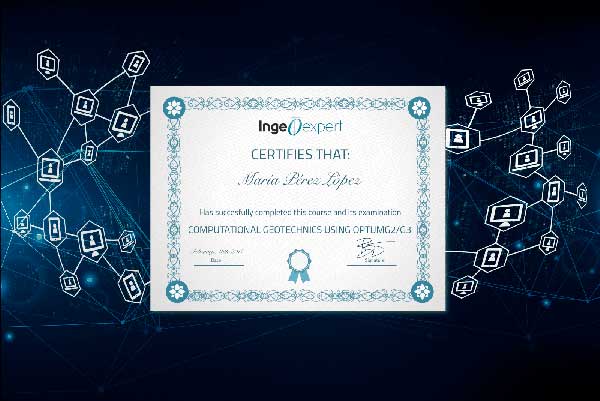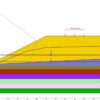Basement excavation modelling using PLAXIS 2D
Online course |
|
50 hours / 5 weeks |
|
|
Dates: 9th of September to 14th of October |
| Standard | Unemployed Or Student |
| $313 | $248 |
In collaboration with Bentley Systems
PLAXIS 2D license included
Get an official certificate provided by Bentley Systems
Introduction
The Finite element method (FEM) is a powerful numerical tool for solving complex engineering problems in several fields, such as deep basement construction in urban areas.
Nowadays, personal computers are equipped with high computing power. Therefore, the FEM is now available in commercial software and became an indispensable software tool to assist the design of basement construction in urban and complex ground conditions.
One of the most popular commercial FEM software for basement excavation modelling is the PLAXIS FE package ( 2D & 3D).
This online course will focus on the usage of PLAXIS 2D software in the modelling and analysis of typical basement excavation problems. Throughout the course, the students will have the opportunity to practice their newly acquired knowledge with hands-on exercises. A temporary PLAXIS 2D license will also be provided to all course participants for the entire event duration so that they can properly run the proposed hands-on exercises.
Objectives
At the end of this course, it is expected the attendees to understand:
- The principles of FEM.
- The PLAXIS 2D modelling workflow.
- How to efficiently set up a basement excavation’s geometry and respective finite element mesh in PLAXIS 2D.
- The Initial stresses and basement de-watering strategies in PLAXIS 2D.
- The Undrained behaviour modelling and the main limitations of each PLAXIS 2D’s undrained type options.
- The basic theory of the most common soil constitutive models used in basement excavation modelling and how to derive the respective soil parameters.
Module 1 – Introduction to PLAXIS 2D modelling workflow
- – Introduction FEM analysis in Geotechnical Engineering
- – Setting up and installing PLAXIS 2D
- – PLAXIS 2D Input and & Output modelling workflow & interface
- – Exercise – Settlement of Footing
Module 2 – Structural elements, meshing and initial stresses generation
- – Structural elements in Basement modelling ( using PLAXIS)
- – Meshing & geometry optimization strategies
- – Initial Stresses generation – K0 procedure and gravity loading
- – Exercise – Ground anchor basement excavation (Mohr-Coulomb)
Module 3 – Constitutive Soil models used in Basement excavation modelling
- – Mohr-Coulomb
- – HS model / HSS model
- – Exercises – Continuation of the Ground Anchor basement excavation (Mohr-Coulomb vs HS vs HSS)
Module 4 – Modelling Groundwater flow in PLAXIS
- – Defining Water conditions in PLAXIS
- – Groundwater flow modelling
- – De-watering strategies for basement excavation modelling
- – Exercises – Basement excavation and de-watering
Module 5 –Undrained behaviour modelling
- – Undrained Behaviour modelling
- – Non-linear analysis and calculation control parameters
- – Exercises –Undrained Excavation using Methods A & B
Francisco Santos Marques
Francisco Santos Marques, CEng MICE, is a Civil/Geotechnical Engineer and he is a certified Bentley’s PLAXIS FE Qualified Trainer.
He received his MSc in Civil Engineering with a major specialization in Geotechnics at Instituto Superior Técnico (Lisbon, Portugal). He is currently a chartered civil/geotechnical engineer with the Institution of Civil engineers (UK) and the Ordem dos Engenheiros (Portugal).
He has over 10 years of experience working as a Geotechnical designer/consultant/specialist engineer in different regions around the world ( Brazil, Netherlands and the UK). He has strong expertise in using numerical modelling and geotechnical design on several high-profile deep basements and complex piled foundation designs in Brazil and UK. He is also knowledgeable in site investigations and geotechnical monitorization works
From 2015 to 2017 he worked as a Geotechnical Support Engineer at PLAXIS BV, providing worldwide support and in-house training on the PLAXIS software package (2D & 3D).
Francisco’s current interests and passions lie in developing automation Python scripts 🐍, to perform data analysis and post-processing on large datasets originating from complex 3D FEM models or site monitoring. He is also very interested in the application of drones’ photogrammetry techniques in the civil/geotechnical engineering field
The course is delivered online through our easy-to-use Virtual Campus platform. For this course, a variety of content is provided including:
– eLearning materials
– Videos
– Interactive multimedia content
– Live webinar classes
– Texts and technical articles
– Case studies
– Assignments and evaluation exercises
Students can download the materials and work through the course at their own pace.
We regularly update this course to ensure the latest news and state-of-the-art developments are covered, and your knowledge of the subject is current.
Live webinars form part of our course delivery. These allow students and tutors to go through the course materials, exchange ideas and knowledge, and solve problems together in a virtual classroom setting. Students can also make use of the platform’s forum, a meeting point to interact with tutors and other students.
The tutoring system is managed by email. Students can email the tutor with any questions about the course and the tutor will be happy to help.
This course is tailored toward practitioners in the industry and Geotechnical/Civil Engineering MSc students to provide a good understanding of the use of the Plaxis 2D program in the field of basement excavation environments. Basic knowledge of Soil Mechanics and Geotechnical engineering principles is required.
Once a student finishes the course and successfully completes the assignments and evaluation tests, they are sent an accreditation certificate. The certificate is issued by Ingeoexpert to verify that the student has passed the course. It is a digital certificate that is unique and tamper-proof – it is protected by Blockchain technology. This means it is possible for anyone to check that it is an authentic, original document.
You will be able to download the certificate in an electronic format from the Virtual Campus platform. The certificate can be forwarded by email, shared on social networks, and embedded on websites. To see an example, click here.
This course will train practitioners that can work in any civil and geotechnical related projects including the
- – Design and construction of deep basements under complex urban and ground conditions
- – Impact assessment on third-party assets caused by a nearby basement excavation
In collaboration with Bentley Systems
PLAXIS 2D license included
Get an official certificate provided by Bentley Systems
Introduction
The Finite element method (FEM) is a powerful numerical tool for solving complex engineering problems in several fields, such as deep basement construction in urban areas.
Nowadays, personal computers are equipped with high computing power. Therefore, the FEM is now available in commercial software and became an indispensable software tool to assist the design of basement construction in urban and complex ground conditions.
One of the most popular commercial FEM software for basement excavation modelling is the PLAXIS FE package ( 2D & 3D).
This online course will focus on the usage of PLAXIS 2D software in the modelling and analysis of typical basement excavation problems. Throughout the course, the students will have the opportunity to practice their newly acquired knowledge with hands-on exercises. A temporary PLAXIS 2D license will also be provided to all course participants for the entire event duration so that they can properly run the proposed hands-on exercises.
Objectives
At the end of this course, it is expected the attendees to understand:
- The principles of FEM.
- The PLAXIS 2D modelling workflow.
- How to efficiently set up a basement excavation’s geometry and respective finite element mesh in PLAXIS 2D.
- The Initial stresses and basement de-watering strategies in PLAXIS 2D.
- The Undrained behaviour modelling and the main limitations of each PLAXIS 2D’s undrained type options.
- The basic theory of the most common soil constitutive models used in basement excavation modelling and how to derive the respective soil parameters.
Module 1 – Introduction to PLAXIS 2D modelling workflow
- – Introduction FEM analysis in Geotechnical Engineering
- – Setting up and installing PLAXIS 2D
- – PLAXIS 2D Input and & Output modelling workflow & interface
- – Exercise – Settlement of Footing
Module 2 – Structural elements, meshing and initial stresses generation
- – Structural elements in Basement modelling ( using PLAXIS)
- – Meshing & geometry optimization strategies
- – Initial Stresses generation – K0 procedure and gravity loading
- – Exercise – Ground anchor basement excavation (Mohr-Coulomb)
Module 3 – Constitutive Soil models used in Basement excavation modelling
- – Mohr-Coulomb
- – HS model / HSS model
- – Exercises – Continuation of the Ground Anchor basement excavation (Mohr-Coulomb vs HS vs HSS)
Module 4 – Modelling Groundwater flow in PLAXIS
- – Defining Water conditions in PLAXIS
- – Groundwater flow modelling
- – De-watering strategies for basement excavation modelling
- – Exercises – Basement excavation and de-watering
Module 5 –Undrained behaviour modelling
- – Undrained Behaviour modelling
- – Non-linear analysis and calculation control parameters
- – Exercises –Undrained Excavation using Methods A & B
Francisco Santos Marques
Francisco Santos Marques, CEng MICE, is a Civil/Geotechnical Engineer and he is a certified Bentley’s PLAXIS FE Qualified Trainer.
He received his MSc in Civil Engineering with a major specialization in Geotechnics at Instituto Superior Técnico (Lisbon, Portugal). He is currently a chartered civil/geotechnical engineer with the Institution of Civil engineers (UK) and the Ordem dos Engenheiros (Portugal).
He has over 10 years of experience working as a Geotechnical designer/consultant/specialist engineer in different regions around the world ( Brazil, Netherlands and the UK). He has strong expertise in using numerical modelling and geotechnical design on several high-profile deep basements and complex piled foundation designs in Brazil and UK. He is also knowledgeable in site investigations and geotechnical monitorization works
From 2015 to 2017 he worked as a Geotechnical Support Engineer at PLAXIS BV, providing worldwide support and in-house training on the PLAXIS software package (2D & 3D).
Francisco’s current interests and passions lie in developing automation Python scripts 🐍, to perform data analysis and post-processing on large datasets originating from complex 3D FEM models or site monitoring. He is also very interested in the application of drones’ photogrammetry techniques in the civil/geotechnical engineering field
The course is delivered online through our easy-to-use Virtual Campus platform. For this course, a variety of content is provided including:
– eLearning materials
– Videos
– Interactive multimedia content
– Live webinar classes
– Texts and technical articles
– Case studies
– Assignments and evaluation exercises
Students can download the materials and work through the course at their own pace.
We regularly update this course to ensure the latest news and state-of-the-art developments are covered, and your knowledge of the subject is current.
Live webinars form part of our course delivery. These allow students and tutors to go through the course materials, exchange ideas and knowledge, and solve problems together in a virtual classroom setting. Students can also make use of the platform’s forum, a meeting point to interact with tutors and other students.
The tutoring system is managed by email. Students can email the tutor with any questions about the course and the tutor will be happy to help.
This course is tailored toward practitioners in the industry and Geotechnical/Civil Engineering MSc students to provide a good understanding of the use of the Plaxis 2D program in the field of basement excavation environments. Basic knowledge of Soil Mechanics and Geotechnical engineering principles is required.
Once a student finishes the course and successfully completes the assignments and evaluation tests, they are sent an accreditation certificate. The certificate is issued by Ingeoexpert to verify that the student has passed the course. It is a digital certificate that is unique and tamper-proof – it is protected by Blockchain technology. This means it is possible for anyone to check that it is an authentic, original document.
You will be able to download the certificate in an electronic format from the Virtual Campus platform. The certificate can be forwarded by email, shared on social networks, and embedded on websites. To see an example, click here.
This course will train practitioners that can work in any civil and geotechnical related projects including the
- – Design and construction of deep basements under complex urban and ground conditions
- – Impact assessment on third-party assets caused by a nearby basement excavation
4 reviews for Basement excavation modelling using PLAXIS 2D
More info
Finish this course and get a certificate based on Blockchain
Basement excavation modelling using PLAXIS 2D


Blockchain technology makes the certificate incorruptible, enabling companies to verifiy its autenticity.
Basement excavation modelling using PLAXIS 2D
| $313 | $248 | |
| Get more information |





Alexandrin Dicu –
I highly recommend this Plaxis course. Modelling strategies related to soil structure interaction, dewatering strategies and simple and advanced constitutive models are discussed in detail and implemented in the hands-on Plaxis models. Answers and explanations have been provided to all questions by Francisco.
stephanie brayshaw –
Engaging and informative. Challenging if new to PLAXIS 2D. Diligent, friendly and skilled teacher. Thank you, Francisco for all the guidance.
Nguyen –
I enjoyed very much the couse. Franciso is an excellent teacher. I appreciated a lot the way he taught, all theoretical and practical aspects. He has such a perfect knowledges of geotechnical engineering and Plaxis 2D modelling. The course is very rich in information and knowledge. The materials of the couses (Plaxis 2D, support documents) were very useful. I highly recommend the couse.
David Sullivan –
Francisco made Plaxis very approachable. I was hesitant to take the class as I had never used Plaxis, but was amazed how quickly I learned with Francisco’s step by step approach to training. It was good doing real world exercises as that made it understandable. Thanks for the excellent training!